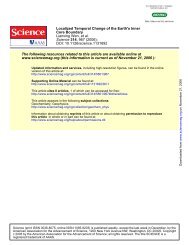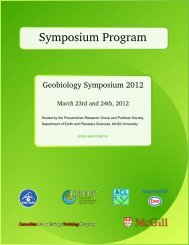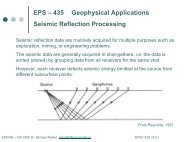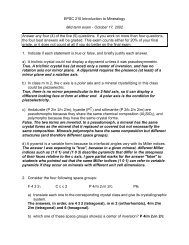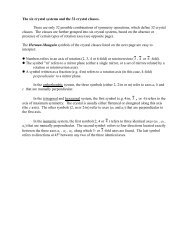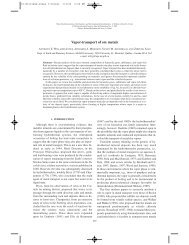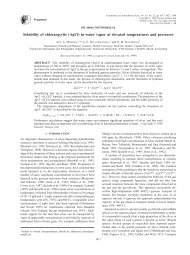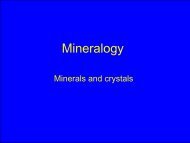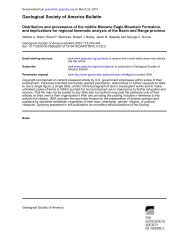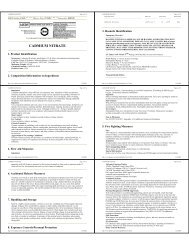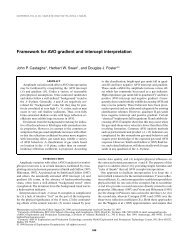05 Classification of.. - Department of Earth and Planetary Sciences
05 Classification of.. - Department of Earth and Planetary Sciences
05 Classification of.. - Department of Earth and Planetary Sciences
You also want an ePaper? Increase the reach of your titles
YUMPU automatically turns print PDFs into web optimized ePapers that Google loves.
Figure 20 Photomicrographs <strong>of</strong> brachinites—(a)<br />
Brachina <strong>and</strong> (b) ALH84025—in transmitted light<br />
with partially crossed nicols. Brachina has an equigranular<br />
texture <strong>of</strong> olivine, augite, <strong>and</strong> plagioclase, with<br />
minor chromite, FeNi-metal, <strong>and</strong> sulfides. ALH84025<br />
has an equigranular texture <strong>of</strong> olivine <strong>and</strong> augite with<br />
fine twin lamellae <strong>and</strong> interstitial troilite (black). Note<br />
coarse grain size (compared to Brachina) <strong>and</strong> absence<br />
<strong>of</strong> plagioclase (photograph courtesy <strong>of</strong> M. Wadhwa).<br />
the line with slope ,1 nearly identical to the<br />
carbonaceous chondrite anhydrous mineral line<br />
(Goodrich, 1992; Clayton <strong>and</strong> Mayeda, 1996).<br />
Based on the mineralogy <strong>and</strong> petrology,<br />
ureilites are divided into three groups (lithological<br />
types): (i) olivine–pigeonite ureilites,<br />
(ii) olivine–orthopyroxene–(augite) ureilites,<br />
<strong>and</strong> (iii) polymict ureilites.<br />
The olivine–pigeonite ureilites (Figure 21(a)),<br />
which constitute .90% <strong>of</strong> all ureilites, are coarse<br />
grained (average grain size ,1 mm), highly<br />
equilibrated assemblages <strong>of</strong> ,80 vol.% <strong>of</strong> olivine<br />
ranging in composition from Fo 76 to Fo 95 (olivine<br />
compositions within each ureilite are homogeneous),<br />
<strong>and</strong> uninverted pigeonite. Many have<br />
pronounced fabric, defined by both a lineation<br />
<strong>and</strong> a foliation (Figure 21(a)). Graphite occurs<br />
mainly along grains boundaries (Figure 21(c)).<br />
Most <strong>of</strong> the olivine–orthopyroxene–(augite)<br />
ureilites have poikilitic textures, consisting <strong>of</strong><br />
large (up to ,5 mm) oikocrysts <strong>of</strong> low-calcium<br />
pyroxene (either orthopyroxene or inverted<br />
<strong>Classification</strong> <strong>of</strong> Nonchondritic Meteorites 109<br />
pigeonite) enclosing rounded chadocrysts <strong>of</strong><br />
olivine <strong>and</strong> augite (Figure 21(b)); all these<br />
minerals may contain magmatic inclusions<br />
(Figure 21(d)), which are absent in olivine–<br />
pigeonite ureilites (Goodrich et al., 2001).<br />
META78008, one <strong>of</strong> the olivine–orthopyroxene–(augite)<br />
ureilites, contains some pigeonite<br />
(Berkley <strong>and</strong> Goodrich, 2001).<br />
The polymict ureilites are fragmental breccias<br />
<strong>and</strong> regolith breccias containing solar-windimplanted<br />
gases. They consist almost entirely <strong>of</strong><br />
mineral <strong>and</strong> lithic clasts <strong>of</strong> olivine–pigeonite<br />
<strong>and</strong> olivine–orthopyroxene–(augite) ureilite<br />
materials. In addition, there are plagioclase clasts,<br />
feldspathic melts clasts, Ca–Al–Ti-rich clasts<br />
that resemble angrites, heavily hydrated clasts <strong>of</strong><br />
CI-like materials, <strong>and</strong> chondritic fragments (Prinz<br />
et al., 1986, 1987, 1988; Ikeda <strong>and</strong> Prinz, 2000;<br />
Ikeda et al., 2000; Kita et al., 2000).<br />
The olivine–pigeonite ureilites are now<br />
accepted to be residues from at least 15%<br />
melting, the minimum required to eliminate<br />
plagioclase from a generally chondritic parent<br />
body (Warren <strong>and</strong> Kallemeyn, 1992; Scott et al.,<br />
1993; Goodrich et al., 2002), whereas the<br />
olivine–augite–orthopyroxene ureilites appear<br />
to be cumulates (Goodrich et al., 2001). The<br />
small percentage <strong>of</strong> feldspathic material in<br />
polymict ureilites may sample the missing<br />
basaltic crust <strong>of</strong> the ureilite parent body.<br />
1.<strong>05</strong>.4.2.5 HED meteorites: howardites,<br />
eucrites, diogenites<br />
The HED meteorites have traditionally been<br />
classified into one group, because there is strong<br />
evidence that they originated on the same<br />
asteroidal parent body (Drake, 2001). This<br />
evidence includes their identical oxygen isotopic<br />
compositions (Figure 17), similarities in Fe/Mn<br />
ratios <strong>of</strong> pyroxenes (e.g., Papike, 1998), the<br />
occurrence <strong>of</strong> polymict breccias consisting <strong>of</strong><br />
materials <strong>of</strong> eucritic <strong>and</strong> diogenitic parentage<br />
(e.g., the howardites; Fredriksson <strong>and</strong> Keil<br />
(1963)), <strong>and</strong> the existence <strong>of</strong> rocks intermediate<br />
between diogenites <strong>and</strong> cumulate<br />
eucrites (Takeda <strong>and</strong> Mori, 1985). Similarities<br />
in the mineralogical compositions <strong>of</strong> the<br />
HEDs <strong>and</strong> the surface mineralogy <strong>of</strong> asteroid 4<br />
Vesta, as determined by ground-based visible<br />
<strong>and</strong> near-infrared spectroscopy, suggest that the<br />
HEDs are impact ejecta <strong>of</strong>f 4 Vesta (McCord<br />
et al., 1970). This proposal has been strengthened<br />
by the discovery <strong>of</strong> the so-called “Vestoids” <strong>of</strong><br />
the Vesta family, which are small (,10 km<br />
diameter) asteroids that are dynamically linked<br />
to Vesta (e.g., Binzel <strong>and</strong> Xu, 1993).<br />
The HEDs are discussed in order <strong>of</strong> increasing<br />
depth in their parent body, as suggested by Takeda



